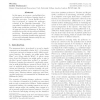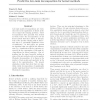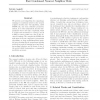ICML
2005
IEEE
16 years 1 months ago
2005
IEEE
In many domains, a Bayesian network's topological structure is not known a priori and must be inferred from data. This requires a scoring function to measure how well a propo...
87
Voted
ICML
2005
IEEE
16 years 1 months ago
2005
IEEE
In this paper, we review the paradigm of inductive process modeling, which uses background knowledge about possible component processes to construct quantitative models of dynamic...
110
Voted
ICML
2005
IEEE
16 years 1 months ago
2005
IEEE
In this paper, we propose two new support vector approaches for ordinal regression, which optimize multiple thresholds to define parallel discriminant hyperplanes for the ordinal ...
114
click to vote
ICML
2005
IEEE
16 years 1 months ago
2005
IEEE
Clustering aims to find useful hidden structures in data. In this paper we present a new clustering algorithm that builds upon the consistency method (Zhou, et.al., 2003), a semi-...
111
Voted
ICML
2005
IEEE
16 years 1 months ago
2005
IEEE
In a data streaming setting, data points are observed one by one. The concepts to be learned from the data points may change infinitely often as the data is streaming. In this pap...
ICML
2005
IEEE
16 years 1 months ago
2005
IEEE
In this paper, we propose a probabilistic kernel approach to preference learning based on Gaussian processes. A new likelihood function is proposed to capture the preference relat...
91
Voted
ICML
2005
IEEE
16 years 1 months ago
2005
IEEE
Low-rank matrix decompositions are essential tools in the application of kernel methods to large-scale learning problems. These decompositions have generally been treated as black...
80
Voted
ICML
2005
IEEE
16 years 1 months ago
2005
IEEE
We introduce a novel algorithm for decision tree learning in the multi-instance setting as originally defined by Dietterich et al. It differs from existing multi-instance tree lea...
71
Voted
ICML
2005
IEEE
16 years 1 months ago
2005
IEEE
We present a novel algorithm for computing a training set consistent subset for the nearest neighbor decision rule. The algorithm, called FCNN rule, has some desirable properties....
101
click to vote
ICML
2005
IEEE
16 years 1 months ago
2005
IEEE
This paper concerns the experimental assessment of tempering as a technique for improving Bayesian inference for C&RT models. Full Bayesian inference requires the computation ...



